 |

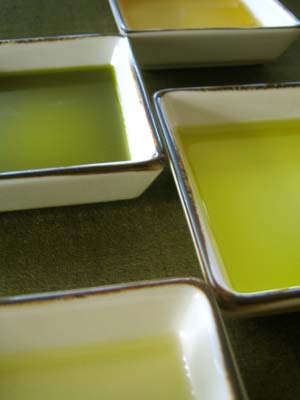 |
| The different colors of Olivado’s infused avocado oils. Photo
above and bread photo by Melody Lan. |
Olivado Avocado Oil:
Deliciously Healthy
The holiday season is tough on the waistline. That’s why we’re making our first product recommendations of the new year delicious and good for you.
Avocado oil has moved from the health food ranks to the shelves of specialty food stores, thanks in large part to avocado growers in New Zealand. Over the last 30 years they have turned the Bay of Plenty region into one of the world’s premium avocado-growing areas. In the last decade they developed technology that removed the natural bitterness of the oil and stabilized it for a longer shelf life. The result: gourmet-quality, heart-healthy avocado oil that can compete with olive oil for your gustatory affections. Not all of the oils taste like avocado, so you can enjoy some of them even if you’re not an avocado fan.
Olivado Gourmet Foods, the producer of today’s featured oils, created quite a buzz when it showed its products at the Fancy Food Show a year ago. The company processes avocados into the essence of avocado, a rich, deep green oil, using the traditional cold-pressed method employed for centuries by the olive oil industry. (Olivado makes both types of oil—the name is a combination of olive and avocado.) Using the extraction method, they also create four infused (flavored) avocado oils, which taste not at all of avocado, but of the herb, spice or fruit with which each is infused.
You can think of avocado oil much in the same way you think of olive oil—tasty and versatile. It is not meant to replace olive oil, but to bring new flavors to the table and to provide more flexibility in cooking—it has the highest smoke point of any cooking oil.* If you have tasted other avocado oils, they may have been distant relatives of the gourmet New Zealand products. Traditionally avocado oil is made from the bruised fruit that cannot be sold. Olivado found that the bruising affected the flavor profile, so only first-quality fruit is used. (In fact, 22 avocados are pressed into one 250 ml bottle. Given the price of avocados at the market, the $11.49 cost per bottle may not seem high.)
* The smoke point is the temperature at which an oil begins to decompose from the heat. It gives off visible fumes (smoke) and an unpleasant odor as it breaks down.
The pure, cold-pressed product is called Extra Virgin Avocado Oil because of its low acidity (.2%). This designation parallels the criteria for Extra Virgin Olive Oil (below 1% acidity). The flavor of the oil is pure liquid avocado, and avocado lovers must try it (it’s a great gift for anyone who always has an avocado ripening on the counter). Just as a great olive oil adds its unique notes to salads, vegetables, and whatever it anoints, people will notice something special when Extra Virgin Avocado Oil is in the mix.
In the case of the infused oils, called Golden Avocado Oils, the heavy avocado taste of the Extra Virgin version has been extracted so that the infused flavors predominate—and they are spectacular. We have enjoyed infused olive oils for years, and have written about them in a previous NIBBLE newsletter. The Olivado infused avocado oils are lighter and just zing with taste, making us, already converts to infused oils in general, newly enchanted by them. We hastened to find a compartmentalized dish where we could pour all four flavors to use as bread dippers: while dipping one flavor on its own was exciting, switching among the flavors was a feast—a happy substitute for dinner.
But there’s much more to do than dip. All of the oils make terrific salad dressings, cooking and anointing oils (an anointing oil is a condiment oil—one that is used as a surface accent). We used them instead of olive oil and butter, with great results. (See “How We Used The Oils,” below.) |
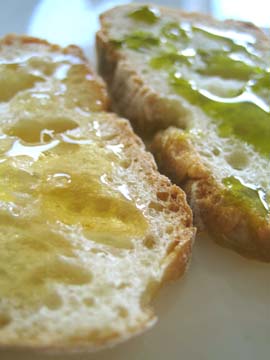 |
Cooking With Avocado Oil
If you like to fry and sauté, you may have found your oil. Many cooks who prefer the flavor that olive oil adds to dishes have had to substitute the blander safflower or corn oils because of their higher smoke points.
Avocado oil is the mother of smoke points: up to 520°F.† It makes a big difference when searing meat, frying foods or making stir-frys.‡
† The exact smoke point of a vegetable oil will vary according to the variety and growing conditions of the vegetable, and how the oil was produced. After avocado oil (520°F) come safflower oil (510°F), soybean, corn, peanut and sunflower oils (450°F), and refined sesame oil (450°F). Olive oil is about 380°F, but you will see numbers that vary widely. Filtered oil will smoke at a higher point than unfiltered oil, which has pieces of fruit in it, and extra virgin will smoke at a different heat than processed oil (simply called “olive oil”). Pomace oil, made from the pressed flesh and pits, has the highest smoke point among olive oils.
‡ When frying, the best results occur when the oil is very hot. When foods are placed into hot oil, their natural sugars caramelize and the proteins denature into a thin shell. This protects the food from soaking up the oil: the outside becomes crisp and the interior is just cooked.
|
 |
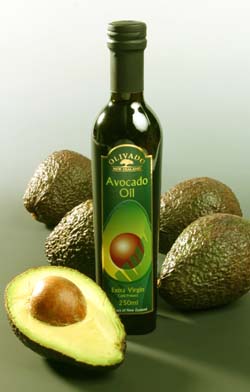
It is fun being green—and delicious, too. Each
250 ml bottle of oil contains the juice of 22 avocados!
|
Health Benefits
Read some reports about avocado oil and it begins to sound like snake oil. There are claims that it fights heart disease, protects against diabetes, macular degeneration, prostate and other cancers. There are even claims that it reduces wrinkles (it’s been a beauty product and medicinal additive for quite a while). Hype aside, it does seem true that avocado oil is the healthiest of food oils. The cold-pressed (Extra-Virgin) oil contains:
- The highest level of heart-healthy monounsaturated fats and omega 3 fatty acids, which lower blood cholesterol
- The highest levels of alpha and beta carotene, which protect against heart disease (it has been approved as a heart-healthy oil by the New Zealand and Australian Heart Foundations)
- Twice the lutein of olive oil, which protects against macular degeneration and blindness
- High levels of several essential vitamins and minerals, including the powerful antioxidant, vitamin E
How much do you have to consume to reap the benefits? Studies are constantly underway, but based on those to date, start by consuming two to four tablespoons a day. It can be in food preparations, or just consumed by the tablespoon.
It’s important to note that the flavored oils require refining prior to the infusion, which removes much of the chlorophyll and plant steroids. The oils still have the heart-healthy monounsaturated profile and the antioxidant vitamin E; but the alpha and beta carotene and lutein exist at much lower levels. So, those seeking the full spate of health benefits should stick to the Extra Virgin oil. |
How We Used The Oils
The avocado accents of Extra Virgin Avocado Oil are much more subtle when you cook with them than when they are used as a dressing or condiment. The flavors of the infused oils are always vibrant, and add excitement to everything they touch—we even enjoyed drinking them from the spoon. Basil complements anything the herb works with: meats, vegetables, pasta, goat cheese. Chili & Bell Pepper has no discernable bell pepper flavor but does have hints of ginger—no complaints there! It also has a capsaicin kick—and although we are not hot sauce users, we love it. Rosemary is redolent of the fresh herb, with nuances of lemon. It complements most meats (lamb and chicken are obvious choices) and also makes a superb drizzle over salads, pasta and potatoes (we especially enjoyed making rosemary mashed potatoes). Lemon has a fresh, natural citrus lilt. It’s wonderful on salads, vegetables, fish, seafood, and chicken. |
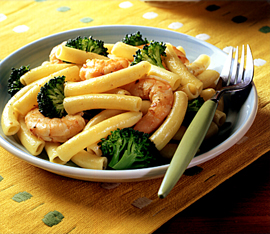
The avocado oils pair beautifully with seafood, vegetables and pasta—and in this dish, tossed with all three! Photo courtesy of the National Pasta Association. |
As a general rule, less avocado oil is needed than olive oil due to its viscosity: It coats food more finely. Some directions say that you can use as much as half the amount in cooking. We were perhaps overgenerous with the copious supply we had on hand.
Here’s how you can spend a day with avocado oils:
| Breakfast |
- Cook eggs in them.
- Dip toast in them (those who don’t like jams and jellies may enjoy the piquant infusions as an alternative to bland spreads).
|
| Lunch |
- Make a vinaigrette (we love balsamic) for any salad, or drizzle it over an actual avocado. We especially loved the infused oils on a citrus salad—grapefruit and orange segments with microgreens and red onion—alone or served with cold poached salmon or seafood.
- Combine them with soy sauce as a dip for sushi, sashimi, or seafood. The Chili & Bell Pepper and the Lemon bring nouvelle flavors to the mix.
- Use them as a bread spread: we brushed the flavored oils on sandwich breads, and plan to make savory mayonnaises with them.
- Toss them with hot pasta or make a cold pasta salad. The flavor you select adds that much more to the pasta recipe.
|
| Dinner |
- Sauté and fry with them, of course. Here, the infused flavors add even more to recipes than the plain avocado oil.
- The same goes for marinades, and for basting fish, chicken, roasted potatoes and vegetables, in the oven or on the grill.
- Drizzle the oil over cooked fish, steamed vegetables, and baked or mashed potatoes.
- Use them to add flavor to any dish, from soups to stews. Chili & Bell Pepper seems made for Asian dishes, Southwestern cuisine, and chili.
|
| Snacks |
- Dip crudités, breadsticks, and thin slices of baguette into the oils.
- Substitute them for other oils in dips and spreads.
|
| |
If we had to help you decide which to choose, we’d say: If you love heat, don’t miss the Chili & Bell Pepper. If you love rosemary, this Rosemary Oil is the freshest infusion of the herb in oil that we can recall. If you love lemon, you’ll never need a fresh one when you use the Lemon Oil. If you adore the flavor of avocado, enjoy it in its intensity as Extra Virgin Avocado Oil.
Don’t worry about having too much if you order a few different flavors. As you can see, you won’t run out of uses. You may even look for reasons to add more omega 3s and vitamin E to your daily diet, under the guise of healthier eating. Now, if we could only tear ourselves away from baguette-dipping and focus more on the salads....
—Karen Hochman
FORWARD THIS NIBBLE to your avocado-loving friends, to people who love to cook, and to anyone who wants to eat more healthfully.
OLIVADO INFUSED AVOCADO OILS
Infused Gold Avocado Oils: Basil, Chili & Bell Pepper, Lemon, Rosemary Infused Oils;
Extra Virgin Avocado Oil
- 250 ml Bottle (8.45 Ounces)
$11.49
Purchase online at GourmetFoodMall.com
To order by telephone call 1.954.454.5218,
or write InfoUSA@Olivado.com.
Prices and flavor availability are verified at publication but are subject to change. Shipping is additional.
The oils are available at Gristedes, Publix, Shop ‘n Save, and other supermarkets.
|
 |
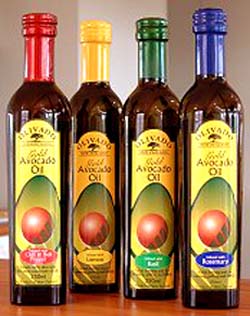
The caps and neck foils are conveniently color-
coded. Red=Chili & Bell Pepper, Yellow=Lemon, Green=Basil, Blue=Rosemary.
|
Ready, Set, Serve
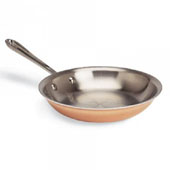 |
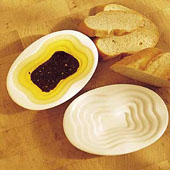 |
 |
All-Clad Cop-R-Chef 12” Frying Pan. If you’re a great cook who likes to sear and sauté, you deserve the best. This top-of-the-line frying pan from All-Clad can take the heat. Its sloped sides make cleanup a breeze. Click here for more information. |
Wave Dipping Bowl. These white bowls are perfect for showcasing the beautiful colors of avocado oils. Buy one for every flavor and have a tasting party. Click here for more information. |
Capped Glass Bottles. If you don’t like serving from the store bottle, you may prefer these. Set of 4. Click here for more information. |
Veggie Delights
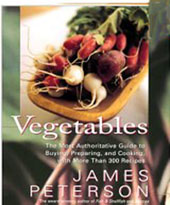 |
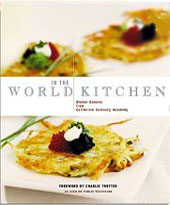 |
 |
Vegetables, by James Peterson. Peterson relates, in detail, the best ways to prepare all of your favorite vegetables and a handful you may not even be familiar with—yet. Substitute avocado oil for olive oil in some of his 300-plus recipes and head for the produce aisle. Click here for more information. |
In the World Kitchen: Global Cuisine from California Culinary Academy, by California Culinary Academy. Nothing says California Cuisine like avocados. Take inspiration from these left-*coast recipes and find new uses for your avocado oils. Click here for more information. |
A Year in a Vegetarian Kitchen: Easy Seasonal Dishes for Family and Friends, by Jack Bishop. Bishop, a Cook’s Illustrated editor, proves that vegetarian cooking can be fun and delicious enough fill your nightly menus. A great way to kick off your healthy lifestyle in the new year. Click here for more information.
|
FOR ADDITIONAL INFORMATION, special offers,
contests, opinion surveys, THE NIBBLE
prior issues archive, product gift-finder and more,
visit the home page of TheNibble.com.
| Do you have friends who would enjoy THE NIBBLE? Click here to send them an invitation to sign up for their own copy. |
ABOUT THE NIBBLE. THE NIBBLE, Great Food Finds, is an online magazine plus newsletters about specialty foods and the gourmet life. It is the only consumer publication and website that focuses on reviewing the best specialty foods and beverages, in every category. The magazine also covers tabletop items, gourmet housewares, and other areas of interest to people who love fine food.
© Copyright 2004-2006 Lifestyle Direct, Inc. All rights
reserved. All information contained herein is subject to change at any time
without notice. All details must be directly confirmed with manufacturers, service
establishments and other third parties. The material in this newsletter may not
be reproduced, distributed, transmitted, cached, or otherwise used, except with
the prior written permission of Lifestyle Direct, Inc.
|
 |
|
 |















